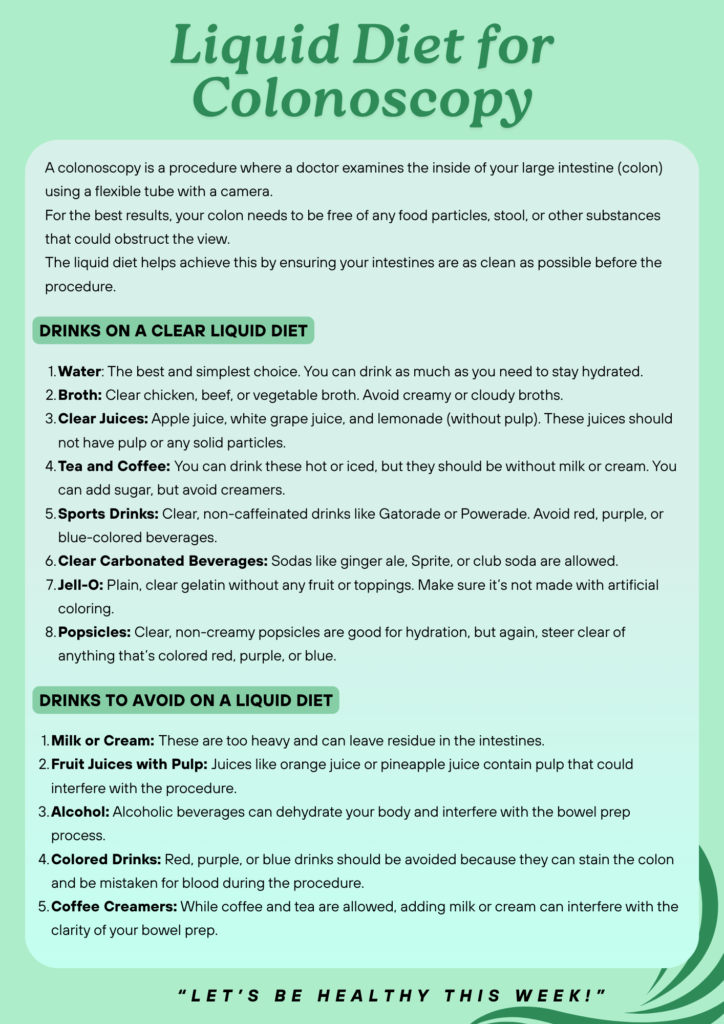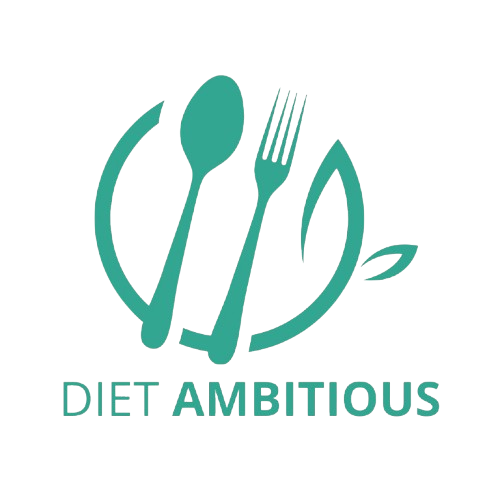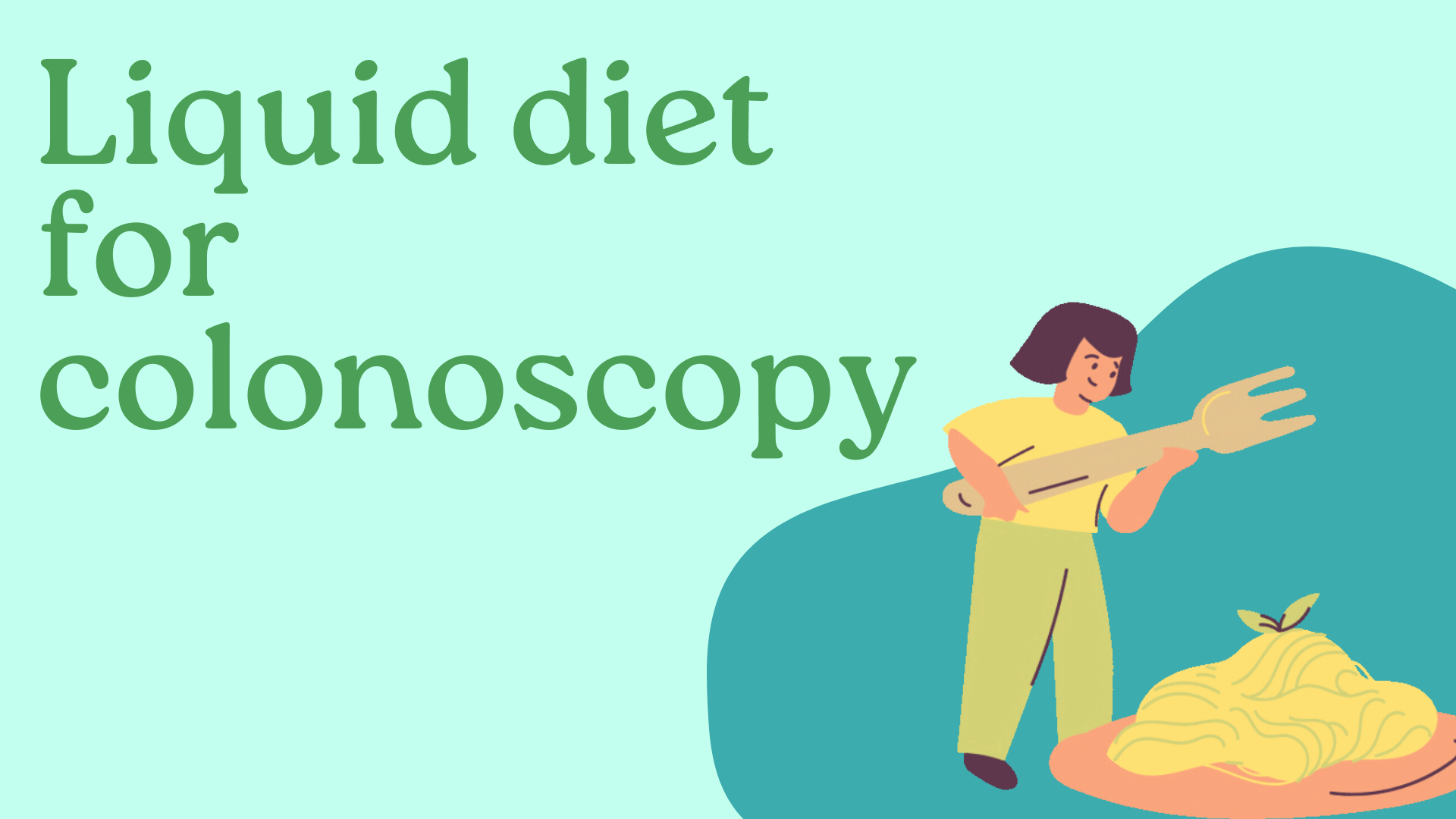If you’ve been scheduled for a colonoscopy, one of the key preparations you’ll need to follow is the liquid diet for colonoscopy. A liquid diet before the procedure is essential for clearing out your intestines and ensuring the doctor can get a clear view of your colon during the exam.
Table of Contents
This guide will walk you through what you can and cannot eat on a liquid diet for a colonoscopy, tips for making the process easier, and why it’s important to follow your doctor’s instructions.
Why Is a Liquid Diet Important for Colonoscopy Preparation?
A colonoscopy is a procedure where a doctor examines the inside of your large intestine (colon) using a flexible tube with a camera.
For the best results, your colon needs to be free of any food particles, stool, or other substances that could obstruct the view.
The liquid diet helps achieve this by ensuring your intestines are as clean as possible before the procedure.
By consuming clear liquids, you allow your digestive system to stay empty, so the doctor can thoroughly examine your colon.
In addition to the liquid diet, you’ll also need to follow a bowel prep regimen prescribed by your healthcare provider, usually involving laxatives or other methods to clear out your system.
What You Can Drink on a Clear Liquid Diet
Here are some of the liquids that are generally allowed:
- Water: The best and simplest choice. You can drink as much as you need to stay hydrated.
- Broth: Clear chicken, beef, or vegetable broth. Avoid creamy or cloudy broths.
- Clear Juices: Apple juice, white grape juice, and lemonade (without pulp). These juices should not have pulp or any solid particles.
- Tea and Coffee: You can drink these hot or iced, but they should be without milk or cream. You can add sugar, but avoid creamers.
- Sports Drinks: Clear, non-caffeinated drinks like Gatorade or Powerade. Avoid red, purple, or blue-colored beverages.
- Clear Carbonated Beverages: Sodas like ginger ale, Sprite, or club soda are allowed.
- Jell-O: Plain, clear gelatin without any fruit or toppings. Make sure it’s not made with artificial coloring.
- Popsicles: Clear, non-creamy popsicles are good for hydration, but again, steer clear of anything that’s colored red, purple, or blue.
What You Should Avoid on a Liquid Diet
While it may seem like there’s a lot you can drink, there are several liquids that are off-limits during the preparation for a colonoscopy:
- Milk or Cream: These are too heavy and can leave residue in the intestines.
- Fruit Juices with Pulp: Juices like orange juice or pineapple juice contain pulp that could interfere with the procedure.
- Alcohol: Alcoholic beverages can dehydrate your body and interfere with the bowel prep process.
- Colored Drinks: Red, purple, or blue drinks should be avoided because they can stain the colon and be mistaken for blood during the procedure.
- Coffee Creamers: While coffee and tea are allowed, adding milk or cream can interfere with the clarity of your bowel prep.
How to Manage Hunger on a Liquid Diet for Colonoscopy
It’s common to feel hungry during a liquid diet, as you’re used to eating solid food. Here are some tips to make the experience more manageable:
- Stay Hydrated: Drinking plenty of water or broth can help you feel fuller and more satisfied.
- Split Meals: Instead of having large servings at once, consider spreading out your liquid intake throughout the day. This can help maintain your energy levels and keep hunger at bay.
- Keep Busy: Distractions like reading, watching TV, or doing light activities can help take your mind off food.
- Choose Flavorful Liquids: When possible, choose a variety of liquids to prevent monotony—mixing different clear juices, teas, and broths can make things feel more interesting.
- Jell-O and Popsicles: These can add a little sweetness to your day and can help make the diet feel less restrictive.
Conclusion
Preparing for a colonoscopy may feel like a lot of work, but following a clear liquid diet and the bowel prep instructions your doctor gives you will make the procedure easier and more effective.
By sticking to liquids that are clear and free of any solid particles, you’ll ensure that your colon is thoroughly cleaned out for the exam.
Though the process may be uncomfortable, remember that it’s a necessary step to ensure a successful colonoscopy and accurate results.
Stay hydrated, stick to the guidelines, and you’ll be ready for your procedure.





